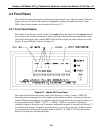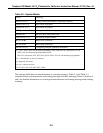
Teledyne API Model 401 O
3
Photometric Calibrator Instruction Manual, 01124, Rev. J2
2 OPERATION
2.1 Key Features
The important features of the Teledyne API Model 401 Photometric Calibrator are listed below.
2.1.1 O
3
Readout
The Teledyne API Model 401 Photometric Calibrator constantly displays the current ozone
reading
(in PPB) in the upper right hand corner of the alphanumeric display.
2.1.2 O
3
Analog Output
The Teledyne API Photometric Calibrator provides a buffered analog output of the current O
3
readings on each of two pairs of outputs on the rear panel (see Figure 1-2) for DAS and recorder
reporting. The analog outputs provide for 20% overrange. For example, on the 500ppb range the
M401 will correctly report concentrations up to 600 ppb and output up to 6.00 volts to the DAS
and recorder outputs. (See Table 9-4 for setting proper analog output voltage jumpers.)
In addition TEST function values can be routed to a third analog output.
2.1.3 E
2
ROM Backup Of Software Configuration
The Teledyne API Photometric Calibrator has few DIP switches or jumpers that need to be set
by the operator. Configuration of the calibrator is done under software control and the
configuration options are stored in electrically erasable (E
2
) ROM. Thus, configuration options
are saved even when the Analyzer is powered off.
There is one exception to this. The analog output voltage ranges are set by DIP switches on the
A/D-I/O board as shown in Section 9.6.3.
2.1.4 Adaptive Filter
The Teledyne API Photometric Calibrator is able to provide a smooth, stable output by means of
an adaptive filter. During conditions of constant or nearly constant concentration the filter is
allowed to grow to 32 samples (2 minutes) in length, providing a smooth, stable reading. If a
rapid change in concentration is detected, the filter is cut to 6 samples to allow the Analyzer to
quickly respond to rapidly varying signals.
2-1


















